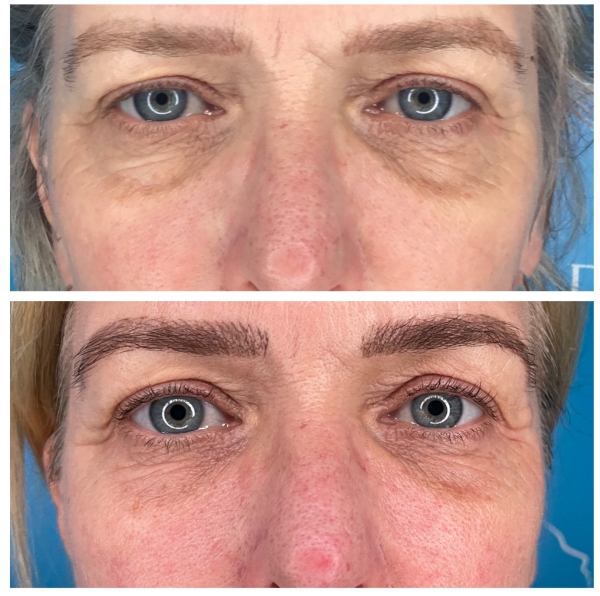Don’t like the thought of Botox or dermal filler? Here’s a natural alternative: Platelet Rich Fibrin (PRF) treatment.
05/04/21
I’m so excited to bring this really natural rejuvenating treatment to my clinic. Here’s some FAQs on what all the fuss is about.
What is it?
Platelet Rich Fibrin (PRF) and Platelet Rich Plasma (PRP) treatments are a way of utilizing your own blood to rejuvenate your skin. Remember that iconic photo of Kim Kardashian’s face smeared in blood? That was PRP needled into the skin to create a lasting glow and radiance, this was termed a Vampire facial.
What’s so good about PRP or PRF?
When blood is taken from your arm, it is spun down to separate the cells that are rich in growth factors. This powerful concentrated serum sits at the top of the test tube and is then extracted. When it is injected it harnesses your body's ability to repair. It stimulates fibroblasts, collagen and elastin to grow and therefore remodels and strengthens your skin leaving you with a fresher, brighter, tighter and rejuvenated complexion. When it tightens it gives an overall smoother complexion with less shadows on the face.
Aesthetic doctors aren’t the only ones using this powerful regenerative potion, it’s also used in other fields such as orthopaedic, cardiac and dental surgery to speed up wound healing and integration of prosthetics.
What’s the difference between PRP and PRF?
PRF treatment is an advanced form of PRP that does not use anticoagulants or other chemical based additives therefore offers a completely natural treatment. It is argued that the results are more impressive with PRF as more growth factor is delivered per ml.
What skin issues does PRF or PRP treat?
It’s a great natural alternative to Botox, dermal fillers and mesotherapy as it improves photo damage, fine lines, scars, pigmentation, poor skin texture and hair loss. In particular crepey, loose and dark skin under the eyes and crowsfeet can be dramatically improved. It is helpful for the general texture and turgor of the skin.
It is also a good combination treatment to be used alongside other aesthetic treatments like Botox, dermal fillers, thread lifts etc.
How is it injected into the skin?
This depends. On discussion with your aesthetic doctor you may want it micro-needled into the skin, in a Kardashian like manner. Or you could have it placed in the skin with a cannula in a blanket-like and needle-less manner. You will be advised what is likely to give you the best results. The treatment intervals are 4-6 weeks apart and expect to need at least 3 or 4 sessions.
When do I see the results?
Results are seen around 8 weeks after 2nd treatment but everyone is different and you may require the recommended 4 sessions before results are seen. The photograph shown of the under eyes was the results 8 weeks after the second session. The skin will continue to improve gradually over the next 3-6 months. Everyone's skin is different and regenerative capacity depends on your age and lifestyle factors.
How long do the results last?
For fine lines and wrinkles the results can last 9-12 months, however scar treatment results usually last indefinitely. Even though your own collagen has a 1/2 life of 7 years, your skin will continue to age and this is why you will want top ups. The time intervals between top ups will depend on your rate of ageing and your aesthetic goals.
What are the possible complications or downsides to PRF?
There are very few side effects or problems caused by PRF treatments. Please expect a little bruising as with all injectable treatments. It is a brilliant safe alternative to fillers for those who have autoimmune conditions or severe allergies as there is no chance of reacting to your own blood products.
Who is it not suitable for?
It isn’t possible to get volume restoration with either PRP or PRF. It conditions and gives a hydrated, fresh appearance to the skin, it will not replace marked volume loss. It would be fantastic if it did. However it does create a soft plumping hydrated effect under the eyes.
It’s not suitable for patients who need to take medications like aspirin or sulphasalazine. This is because these medications impair the platelets ability to create growth factors and other hormones needed for rejuvenation.
Because the procedure involves taking blood, it’s not suitable for those who have a severe bleeding disorder. That said, I frequently take blood from patients who take Warfarin or other anti clotting medication so bleeding after blood letting isn’t usually a problem.
What do you need to do to prepare for a treatment?
Aspirin, ibuprofen or other anti-inflammatory medication should not be taken for the 7 days before and after a treatment (if it is medically safe to do so), for the reasons stated above.
It is advised not to take Vitamin E supplements or alcohol for 48 hours prior to treatment as it just makes you more prone to bleeding.
What is the aftercare?
You should wear factor 30/ 50 sun protection during the healing spell, 28 days, to minimise the risk of hyperpigmentation.
Avoid makeup for at least 12 hours as there may be open channels in the skin that infection can spread into.
How much does it cost?
This will depend on the number of vials used and the area treated. To treat one area like the under eyes costs £350 per session or £1000 for a course of 3. To treat the whole face costs £450 per session or £1200 for a course of 3.
I’m in the Chester / Wrexham area, how do I book an appointment with you?
There are lots of benefits to having a PRFtreatment but it also has its limitations. Every consultation is given to educate and guide you about your treatment options, so you are in a position to make an informed choice. To book an appointment click here







